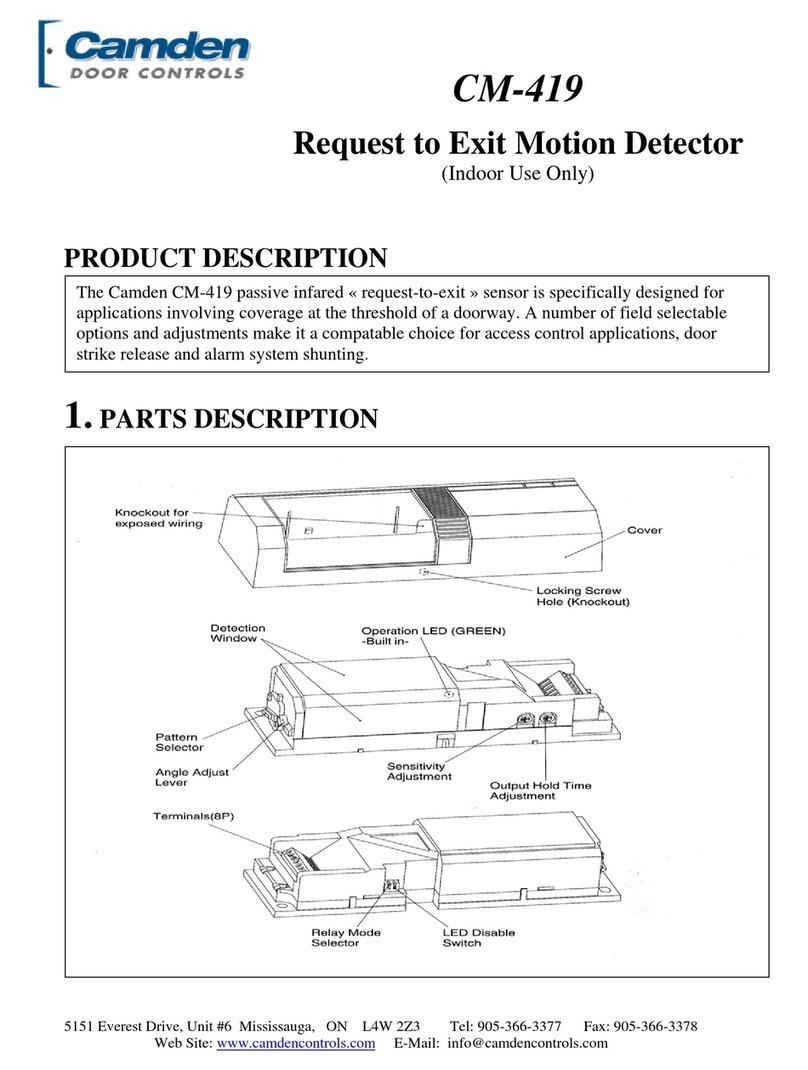
Page 2 of 6
CM-RQE70A PIR ‘REQUEST TO EXIT’ DETECTOR
INSTALLATION INSTRUCTIONS
Tamper Switch
Dry contact outputs N/C are provided for interface to an alarm or
access control systems. The Tamper Switch is connected to a spring that
compresses and closes the switch when the housing cover is installed.
Removing the cover will open the switch contacts providing a change in
state to the monitoring system.
Indicator Lights: LED’s
A Red & Green LED indicates secure vs unsecured status of the REX. The
red LED is normally lit to indicate the door is secure. When a person
walks within the detectable range of the sensor, the green LED will light
and the red will be off.
Access Control Input
Input: Dry N/O A dry contact closure on this input allows a card
reader or keypad on the secure side of the door to activate the REX
sensor allowing access through the secured door.
Sounder Control
Input: Dry N/O A dry contact closure from an external device will hold
this sounder on until it is released. The sounder will not affect the
operation of the relays or relay timers.
Sequential Logic Input
Input: Dry This mode allows a secondary detection device to be
connected to the REX sensor. The REX sensor is active only while this
input is opened or for 10 seconds after it has closed. For example, when
the secondary activation device is activated, the REX sensor functions
normally. When a person is in the eld of view, the sensor is activated
and the door is released. If the secondary activation device is de-
activated, the REX Sensor will continue to be activated if a person is in
the eld of view for an additional 10 seconds.
Door Monitor Contacts
Input: Dry
Operating Functions
Function 1: Latched
When the REX sensor is activated, the relay will remain active as long as the
sensor is activated. Once the sensor is deactivated, the relay will remain on for
the duration of the Relay On Time. If the door is opened, the Relay On Time is
reduced to 2 seconds.
Function 2: Door Prop Open Alarm
The door contact input is used to monitor the status of the door. If the
door is held open during the last 10 seconds of the timer relay set time,
the sounder will annunciate until the door is closed again. If the door
is opened without the REX being activated the sounder will annunciate
until the door is closed or someone has moved into the REX Sensor’s
eld of view.
Function 3: Unauthorized Access Mode
In this mode, when the REX sensor is activated but the door is not
opened, the relay returns to a secured state in 10 seconds. If the REX
sensor is activated and the door opens, then closes, the relay returns to
secured state in 2 seconds.
Function 4: Timed
When the REX sensor is activated, the relay will remain active for the
duration of the Relay On Time. Once the Relay On Time has expired, the
relay drops out. If motion continues, the relay will activate for another full
cycle. If the door is opened, the Relay On Time is reduced to 2 seconds.
External Disable/Enable
Input: Dry
In this mode, the REX is enabled or disabled by an external device, such as
an access control system or security alarm panel. While this input is held
open, the REX sensor will function normally. When this input is closed, the
REX sensor operates the same as in Sequential Logic Input Mode.
Rex Sensor Default Modes
In an effort to make installation easier, we have dened different
installation modes. These modes will cover 90+% of the applications. For
the other 10%, there will be a Custom Mode where all settable functions
can be adjusted.
Mode 1: Normal Latched REX Sensor
The most common mode, the sensor, when activated will enable the
output relay for the duration of the Relay On Time (30 seconds). If a
door contact is connected to Input #1, when the door is sensed to be
opened, then closed, the Relay On Time is reduced to 2 seconds.
Relay On Time: 30s (If the door is opened and closed, the timer is
reduced to 2s)
Fail Mode: Fail Safe
Operating Function: Latched
PIR Sensitivity: 4
Sound Vol: 3
Input #1: Door Contact
Input #2: Press to Exit
Input #3: Sounder Input
Mode 2: Door Prop Alarm
The sensor monitors the status of the door. When activated, the sensor
enables the output relay for 30 seconds. If the door is held open during
the last 10 seconds of the Relay On Time, the piezo will sound until the
door is closed. This mode requires a Door Contact to be connected to
Input #1.
Relay On Time: 30s (If the door is opened and closed, the timer is
reduced to 2s) If the door is held open during the
last 10 seconds of the relay on time, the piezo will
sound until the door is closed.
Fail Mode: Fail Safe
Operating Function: Door Prop Open Alarm
PIR Sensitivity: 4
Sound Vol: 3
Input #1: Door Contact
Input #2: Press to Exit
Input #3: Sounder Input
Mode 3: Access Control
The sensor will activate normally on motion. Input #3 is used to connect
to an access control system. A contact closure on Input #3 will activate
the sensor. A maintained closure on Input #3 will activate the sensor
indenitely.
Relay On Time: 0.5 sec (If the door is opened and closed, the timer
is reduced to 2s)
Fail Mode: Fail Safe
Operating Function: Timed
PIR Sensitivity: 4
Sound Vol: 3
Input #1: Door Contact
Input #2: Press to Exit
Input #3: Card Keypad
























